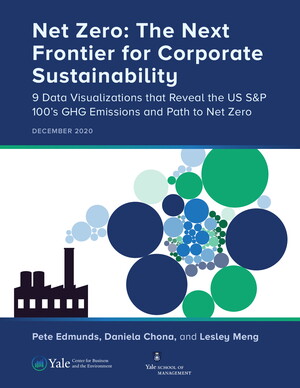Net Zero: The Next Frontier for Corporate Sustainability
9 Data Visualizations that Reveal the US S&P 100’s GHG Emissions and Path to Net Zero

When it comes to climate change, the science is unequivocal: global temperatures will continue to rise for decades, largely due to greenhouse gases produced by human activities. This will have catastrophic effects on human health, infrastructure, energy, agriculture, fisheries, sea levels, natural ecosystems, and more. For many, the consequences have felt distant and theoretical — until now. Unprecedented wildfires, the world’s first climate-induced war in Syria, PG&E’s climate-fueled bankruptcy, devastating hurricanes, and deadly heatwaves — among a litany of other environmental, social, and economic disasters — have changed this. Following the US’ withdrawal from the Paris Agreement on November 4, it is up to corporations to take direct responsibility for their impact on climate change.
While many corporations, investors, regulators, and consumers agree that corporate sustainability is imperative, identifying best practices and which companies are ‘walking the walk’ can be challenging. Corporate metrics, certifications, and coalitions abound, including the Sustainable Accounting Standards Bureau (SASB), the Global Reporting Initiative (GRI), the Science-Based Targets Initiative (SBTi), the Task Force on Climate-related Financial Disclosures (TCFD), the Greenhouse Gas Protocol, the Renewable Energy 100 (RE100), the Business Roundtable, B Corps, and benefit corporations. Greenwashing — a form of marketing that creates a false perception of a company’s environmental sustainability — exacerbates this confusion.
To cut through the noise, our team from the Yale School of Management narrowed in on one, universal metric that is the single biggest driver of climate change: greenhouse gas emissions (GHGs), measured in metric tons of carbon dioxide equivalents. It seems obvious to catalog GHGs from the US’ largest public companies and track their goals for reducing them, but after scouring the internet, it became clear that the data is not publicly available in a free, consolidated format. The Carbon Disclosure Project houses a robust data set on corporate emissions, but requires payment to access, and a crowdsourced Google Doc helps document net-zero pledges, but no data source seems to collect and analyze all of this data in aggregate. To change this, we manually tracked down data on the US S&P 100’s historical GHG emissions since 2015, emissions reduction goals, and emissions reduction initiatives. We then analyzed what we found and have summarized our findings below. While our insights cover a range of topics relevant to corporate emissions, two common themes emerged. First, the private sector desperately needs standardized guidelines for GHG emissions measurement and disclosure. Second, the goal of reaching ‘net zero’ emissions, defined by the IPCC as the equal balancing of anthropogenic greenhouse emissions with anthropogenic greenhouse gas removals over a specific period, has become the new North Star for corporate sustainability.
Our goals are to:
- inspire companies to learn best practices from their peers on the path to ‘net zero,’
- provide a publicly available data source and collection of insights for academics, nonprofits, think tanks, corporations, and others to study, and
- empower concerned global citizens and consumers with information on the culpability of specific US corporations in fueling climate change so that they can more effectively vote with their dollars, select their employers, and support climate policies.
The report is structured around nine data visualizations that communicate the current state of GHG emissions among the US S&P 100 and their stated goals for reducing them. Each visualization is accompanied by an explanation of select insights that can be drawn from them.



